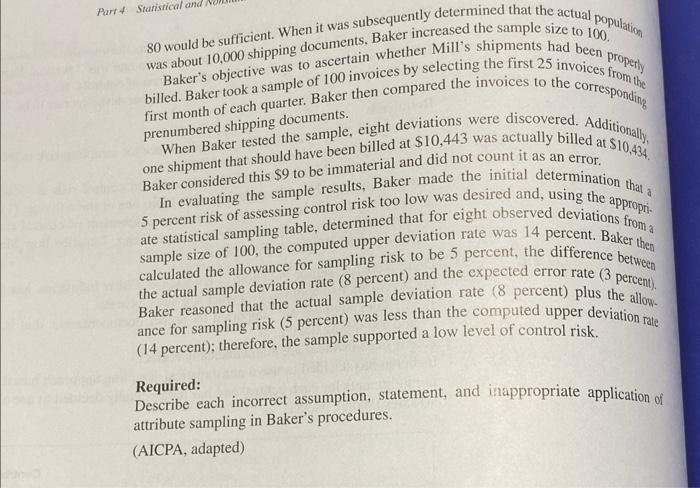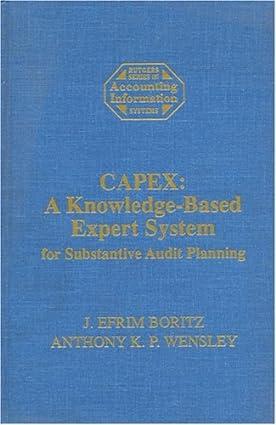3-32 Baker, CPA, was engaged to audit Mill Company's financial statements for the year ended September 30. After studying Mill's internal control, Baker decided to obtain cvidience about the effectiveness of both the design and the operation of the controls that may support a low assessed level of control risk conceraing Mill's shipping and biling functions. During the prior years' audits, Baker had used nonstatistical sampling, but for the current year Baker used a statistical sample in the tests of controls to eliminate the need for judgment. Baker wanted to assess control risk at a low level, so a tolerable deviation rate of 20 percent was established. To estimate the population deviation rate and the computed upper deviation rate, Baker decided to apply an attribute sampling technique that would use an expected population deviation rate of 3 percent for the 8,000 shipping documents and to defer consideration of the allowable risk of assessing control risk too low until the sample results were evaluated. Baker used the tolerable deviation rate, the population size, and the expected population deviation rate to determine that a sample size of 80 would be sufficient. When it was subsequently determined that the actual population was about 10.000 shipping documents, Baker increased the sample size to 100 . Baker's objective was to ascertain whether Mill's shipments had been properly billed. Baker took a sample of 100 invoices by selecting the first 25 invoices from the first month of each quarter. Baker then compared the invoices to the corresponding prenumbered shipping documents. When Baker tested the sample, eight deviations were discovered. Additionally, one shipment that should have been billed at $10,443 was actually billed at $10,434 Baker considered this $9 to be immaterial and did not count it as an error. In evaluating the sample results, Baker made the initial determination that a 5 percent risk of assessing control risk too low was desired and, using the appropri. ate statistical sampling table, determined that for eight observed deviations from a sample size of 100 , the computed upper deviation rate was 14 percent. Baker then calculated the allowance for sampling risk to be 5 percent, the difference between the actual sample deviation rate ( 8 percent) and the expected error rate ( 3 percent). Baker reasoned that the actual sample deviation rate ( 8 percent) plus the allow. ance for sampling risk ( 5 percent) was less than the computed upper deviation rate (14 percent); therefore, the sample supported a low level of control risk. Required: Describe each incorrect assumption, statement, and inappropriate application of attribute sampling in Baker's procedures. (AICPA, adapted)








